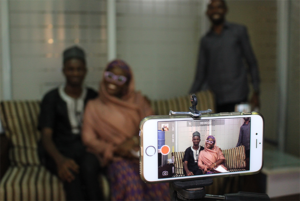Mobile-First Video Approach Helps Youth Share Contraception Information
Stories are incredibly powerful. They help us see an issue in a new light or inspire us to take steps in a different direction.

The FP INFOcus Guide builds the capacity of young people to create and deliver health messages themselves – using mobile phones. Photo credit: Cori Fordham
It is important to keep in mind that stories can motivate us in both positive – and negative ways. When it comes to young people and their family planning decisions, the negative, “I heard a rumor that IUDs can make you infertile” can ring just as loudly as the positive, “My friend’s IUD helped her finish school and start her dream career.” The reality is many young people in low and middle income countries lack access to the health knowledge needed to make informed contraceptive decisions, and are left to rely on stories. While some stories may be helpful – some often contain incomplete or incorrect information or morph into something completely different when shared from person-to-person.
How might we capture young people’s real stories and everyday experiences with contraception in a way that helps decision-making?
This question came up when pretesting materials highlighting the key information and benefits of long-acting reversible contraceptive methods (LARCs). Wanting to build off this work, young people were asked about the additional ways that they would want to learn about their contraceptive options, including LARCs. They said that they would most prefer to receive information on their mobile phones, but also expressed an interest in receiving information through radio soap operas or via Facebook. They also wanted to hear about the experiences of other young people who used LARCs and thought that messages disproving misinformation about LARCs could help others see them as a safe and effective option for young people.
With this demand in mind, the Health Communication Capacity Collaborative (HC3) developed the FP INFOcus Guide, encouraging young family planning champions between the ages of 18 to 24 years old to come together and make short videos about contraception in their community – using their mobile phones. The Guide incorporates elements of mobile-first and participatory video approaches; video formats are designed for mobile phones and content is determined by a group exploring an issue faced by their community. As such, FP INFOcus videos are developed by young people for their peers to view on mobile phones.
The process benefits everyone involved. By preparing, producing and promoting these videos on social media, team members not only improve their ability to strategically promote health through digital storytelling, they also provide viewers with a better understanding of contraceptive options, which help in becoming better equipped to choose a method that meets their needs.
FP INFOcus represents a new approach – not only because of the focus on mobile phone videos and digital storytelling, but also because the young people themselves are developing content for their community. With youth driving the process, the FP INFOcus approach ensures content addresses the main issues faced by their community, and that the stories they choose to tell and how they choose to tell them (e.g., testimonial, skit, dance, game, etc.) will connect with their audience.
HC3 has been working directly with a Nigerian non-profit organization, HACEY Health Initiative, to develop and pilot the FP INFOcus Guide and approach. HACEY has extensive experience working with young people in Nigeria on sexual and reproductive health issues, as well as a background in video-making and social media. As a pilot partner, HACEY has been using the guide to prepare, produce and promote a series of videos filmed on their mobile phones that speak to the benefits and attitudes around LARCs. Video concepts were developed during a February 2017 workshop, when HC3 and HACEY reviewed the guide, identified specific issues they would want the videos to address and started filming and editing. The energy around the project was encouraging. Participants responded to the youth-led and skills-based nature of this project, and felt their peers would be interested in learning health information in this format. It was clear the simple act of showcasing young people’s voices, discussing barriers and solutions, shaping and crafting the content based on the needs and perspectives of their community will help the videos resonate with their viewers, but also created and strengthened family planning champions in the process.
Through our work with young people around the world, we have had the pleasure of meeting many young leaders like those at HACEY who are either interested in or currently promoting reproductive health in their community. It is exciting to see the FP INFOcus Guide supporting and elevating their work and encouraging collective impact.
Sign up for updates to be notified of the Guide’s release, as well as HACEY’s video. Follow the effort on Twitter: #fpINFOcus.







Leave a Reply
Want to join the discussion?Feel free to contribute!